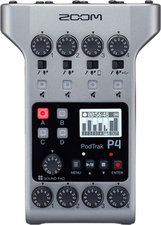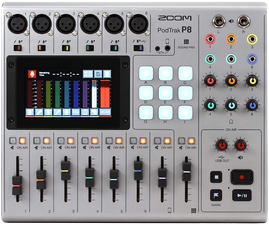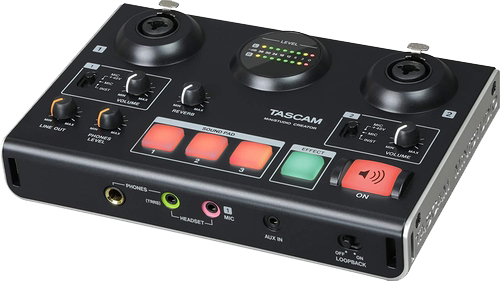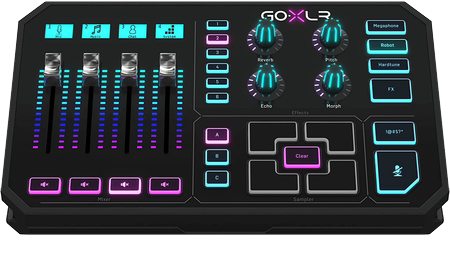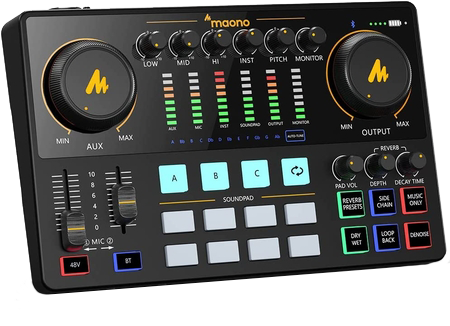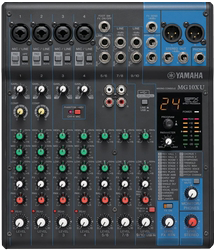Both the first and second generation RODECaster Pros bring a lot to the table. As an all-in-one podcasting mixer, the RODECaster Pro has a lot on its plate, but it finishes the meal and asks for seconds.
From recording and mixing to live streaming (and everything in between), you get a studio’s worth of tools in just one device. The RODECaster Pro is cheaper than a full-fledged studio setup, but it’s still a significant investment.
Unfortunately, this doesn’t work for everyone. Maybe it’s not in your budget, or maybe you like the idea, but it doesn’t fit with your style.
Whatever your reason, we’ve gathered 7 of the best alternatives to the RODECaster Pro (both I and II) to give your podcast a professional edge.
7 Best Alternatives to RODECaster Pro
When looking for suitable alternatives, we focused on the most desirable traits of the RODECaster Pro mixers. These include their versatile design, portability, and ample control options.
Keep reading to find an all-in-one tool that works just as well (if not better) for your podcasting tasks.
1. Zoom PodTrak P4
- 4 XLR inputs
- 4 3.5mm outputs
- 4 programmable keypads
- USB connectivity
- (AA) battery power
If you’re interested in the RODECaster Pro’s versatility and small size, the PodTrak P4 is a great place to start. Zoom already has a reputation in crafting top-tied field recorders, and they bring that expertise to this design.
The PodTrak P4 has a small and easy to handle design that can go with you everywhere. The small size doesn’t sacrifice anything, and you still have 4 XLR inputs for mics so everyone’s voice is heard.
Another major benefit is the ability to record remote guests without a mess of cords. Using the PodTrak P4 with its Bluetooth adapter and Mix-Minus technology simplifies call-in situations.
Pros:
- Small size
- iOS compatible
- Phantom power on all 4 mix inputs
- Cell phone call-in (with Bluetooth adapter)
Cons:
- Small hit to audio quality
- Short battery life (especially with multiple mics)
- Doesn’t come with power cord
2. Zoom PodTrak P8
Key features:
- 3 inch color LCD touchscreen display
- 6 mic inputs with optional phantom power
- 6 headphone outputs
- 9 programmable sound pads
- Individual volume sliders and On-Air indicators for each channel
If the PodTrak P4 sounds nice but you want more opportunity for hands-on controls, Zoom makes a PodTrak P8 that takes things up a notch. This podcast mixer has more I/O options, more sound pads, and onboard editing functionality for trimming, splitting, and fading as you go.
Record as many as 13 tracks simultaneously, then easily transfer the mix to your computer via USB C connection, and continue from there.
The PodTrak P8 works with the same Bluetooth adapter and Mix-Minus technology to prevent annoying echoes and feedback.
This larger model is easier to navigate but remains easy to transport.
Pros:
- Color coding makes for easy navigation
- Potential for wireless call-in
- Plenty of I/Os
Cons:
- Poor audio quality at price
- Need to purchase Bluetooth adapter separately
3. Behringer U-Phoria UMC404HD
Key features:
- 4 inputs with Midas preamp and phantom power
- 4 analog inputs
- MIDI I/O
- 24-bit/192kHz resolution
The Behringer U-Phoria UMC404HD is a nicely sized USB-connected recorder and mixer from a well-known and respectable brand. Don’t let the slim design fool you–you still have phantom power, plenty of input options, and powerful Midas preamps for optimal clarity.
This U-Phoria interface boasts compatibility with popular recording software, such as Avid Pro Tools and Ableton Live. It’s well-designed for podcasters who double in music production, but this may be off-putting for those who don’t play their own tunes.
Those who swear by it plead for new users to not plug in the UMC404HD until the driver is installed, and many negative reviews stem from this issue. As long as you get the driver situation settled first, the Behringer U-Phoria should work just as you need.
Pros:
- Solid casing
- Intuitive, no-frills design
- Powerful preamps and accurate sound
- Wide software compatibility
Cons:
- More musically minded (great for some)
- Some driver difficulty on startup
CHECK BEHRINGER U-PHORIA PRICE
4. TASCAM US-42 MiniStudio Creator
Key features:
- 2 XLR mic inputs with phantom power and individual controls
- TRRS and TRS connections (for gaming headsets)
- 3 sound pads
Tascam’s US-42 MiniStudio Creator took some big ideas, simplified them, and dropped them in a well-designed chassis. While it only hosts 2 XLR mic ports, the MiniStudio Creator ensures you have everything that you need for solo or dual voices in your podcast.
While the interface lacks specific controls, you have all the basics at hand. Control each line individually, then fine tune your recording in the robust Tascam software.
The MiniStudio Creator is great for hands-off podcasters who don’t want to worry about minor adjustments as they go, and the TRRS and TRS connections work perfectly for gaming headsets and live streamers, making it the perfect gift.
If you’re on the other end of the spectrum and want those tactile controls, check out some of the other names on this list.
Pros:
- Works perfectly for solo or dual person podcasts
- Easy to add music to pads
- Computer software unlocks full potential
- Individual controls and simple design
Cons:
- Subpar reverb and effects
- Some features limited with Mac
5. TC-Helicon GoXLR
Key features:
- XLR input
- TRS input
- Optical input
- RGB customization
The GoXLR from TC Helicon has a lot of personality in a small package. While live streamers and gamers make up the bulk of its following, this streaming mixer works perfectly for podcasters (even better if you wear all these hats).
We love the GoXLR for its ability to simplify mixing, wrap it up in an attractive casing, and set down an intuitive layout that even beginners can understand.
The GoXLR computer software houses your more complex controls, like equalizers, and you can work up to these as you learn. It also comes in a mini version.
Compared to GoXLR’s alternatives, everything is close at hand, stylishly designed, and customizable to meet your tastes. You can control all 4 channels in real time while trusting a high-quality Midas preamp to capture every sound perfectly.
Features that boost engagements and effortlessly improve your podcast include real-time sampling, “cough” muting, and a censor bleep (for those that lack a filter). RGB customization is only the icing on the cake.
For a more in-depth comparison, read our RODECaster Pro vs GoXLR article.
Pros:
- Easy censoring with the “!@#$?*” button
- App connectivity
- Great to add to colorful setup
- Clean design
Cons:
- Only one XLR input
- Windows-only
6. MaonoCaster AME2
Key features:
- Plug and play design
- 1 XLR input and 1 3.5mm input
- AUX in
- ¼ inch port
- 11 sound pads with adjustable volume
- 32 bit precision
The AME2 joins the MaonoCaster line with an attractive plug-and-play design. The price is certainly right, especially for solo-podcasters who want full-functionality right in front of them. It not only sits pretty, but it captures crystal-clear sound with 32-bit accuracy.
While it’s not the smallest on the list, the AME2 has a remarkable 8 hours of battery life. Settle in for a recording session knowing you have plenty of time to say what you need.
The AME2 offers independent volume controls for every channel, and you can even set the volume for each of your 11 sound pads to best suit your recording. When paired with smart features, such as noise reduction and dry/wet mode, create the perfect podcast.
Pros:
- Great starter for multi-track recording
- Easy yet complex sound effects
Cons:
- Control audio from monitor knob only (no computer options)
- Potential delay while mic monitoring
- Manual lacking
7. Yamaha MG10XU
Key features:
- 10 input channels (including 4 XLR with phantom power)
- Stereo monitor out
- USB connectivity
- D-PRE preamps
- Built-in digital effects
Yamaha’s MG10XU is the powerhouse you expect from the timeless name. The entire MG series brings forward compact and feature-rich mixers. While its no-frills metal design isn’t the most enticing, every knob exists so you can exert complete control.
This is exactly what you find in professional settings, such as venues or rehearsal rooms, and the MG10XU doesn’t leave you with regret. Use up to 10 input channels to bulk up your podcast and dress them up with Yamaha’s configurable effects tools.
As a baby on the MG line, the MG10XU mixes a stereo track for quick output, so you need to have solid levels when recording.
Pros:
- Quality level with studio and venue use
- Compression works better than most competitors
- Preamps hard at work
Cons:
- USB gets hot
- USB outputs only support one stereo track
Final Recommendation
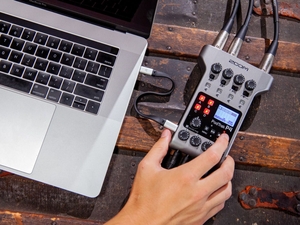 Podcasting has come a long way in a few short years, and tools like the RODECaster Pro have only made it easier for everyone to say what they need.
Podcasting has come a long way in a few short years, and tools like the RODECaster Pro have only made it easier for everyone to say what they need.
These all-in-one podcasting tools turn your bedroom into a studio, and they let you hit the ground running.
When choosing a suitable alternative, figure out what you like most about the RODECaster Pro. Is it the size? The wireless call-in feature? What exactly do you need to make your podcast your own, and which tool can help you meet your goal?
For most, the Zoom PodTrak P4 engulfs all desirable features, keeps your wallet safe, and works even better on the go.

